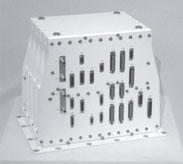Roles of H-IIB Launch Vehicle
The H-IIB Launch Vehicle is Japan’s large-scale rocket whose launch capability is at the highest level in the world. It was successfully developed in a short period by making the best use of technologies acquired through the experience of the H-IIA Launch Vehicle to realize a low-cost and low-risk launch vehicle. The H-IIB Launch Vehicle No. 3 (H-IIB F3) is scheduled to be launched on July 21 (Sat.,) 2012 to inject its payload, the third H-II Transfer Vehicle (HTV3) into its orbit.The H-IIB Test Flight was launched exactly at the scheduled launch time and date on September 11, 2009, and that was the first punctual launch of the first flight of Japan’s major launch vehicles. The H-IIB TF then successfully injected the HTV1 (technological demonstration flight) in its planned orbit. The H-IIB/HTV launch won praise throughout the world including from NASA, and was highly evaluated for its international contribution. As the H-IIB/HTV launch will be the only means for large-size cargo transportation to the International Space Station after the scheduled retirement of the Space Shuttle, the H-IIB F3 will be launched with the high expectations of the world.
H-IIB Configuration

Redeveloped avionics equipment
 For the H-IIB Launch Vehicle No.3, we have efficiently redeveloped a new guidance control computer (GCC) and inertial measuring unit (IMU) by setting the common specifications to the computer board for both of them. For the main (central) processing unit (MPU), the major part of the launch vehicle, we also adopted the MPU for space vehicles that was developed by JAXA. Thus its design technology has been possessed by us, so that we can eliminate our concerns that we may need another large-scale redevelopment when some commercially procured parts are no longer available.
For the H-IIB Launch Vehicle No.3, we have efficiently redeveloped a new guidance control computer (GCC) and inertial measuring unit (IMU) by setting the common specifications to the computer board for both of them. For the main (central) processing unit (MPU), the major part of the launch vehicle, we also adopted the MPU for space vehicles that was developed by JAXA. Thus its design technology has been possessed by us, so that we can eliminate our concerns that we may need another large-scale redevelopment when some commercially procured parts are no longer available.Photo: Guidance control computer (GCC)
In addition, the H-IIB F3 is newly loaded with a Real Time Operating System (RTOS) developed by JAXA Engineering Digital Innovation Center (JEDI center.) The RTOS is an operating system that works on the microprocessor HR5000 for space use with a new-type GCC and IMU.
The RTOS is a system whose mechanism blocks the ripple effect of negative impact to other software when one software experiences an anomaly. Hence it is equipped with a function that can contribute to improve the overall space vehicle system reliability.
